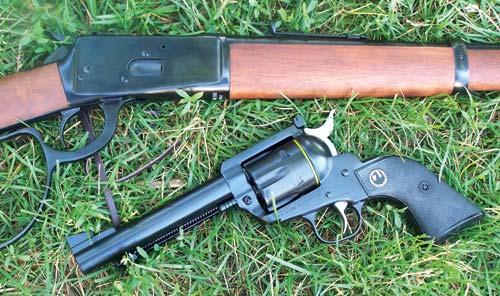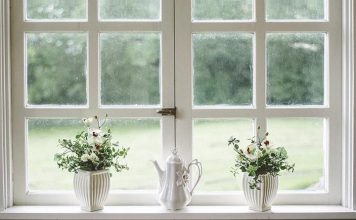|
By Massad Ayoob |
 |
| Issue #137 • September/October, 2012 |
Traditional “old skool” guns, or the most modern and efficient ballistic hardware that money can buy? I asked that question recently on my corner of the Backwoods Home blogs, and as seen here, a whole lot of folks came down on the side of “traditional.”
A part of that answer is in the head, and a part is in the heart. If you’re a long-retired soldier or Marine, you’ve long since bonded with the Model of 1911 .45 caliber pistol that Uncle Sam paid you to learn and protect your country with … and it would be a shame to let that training and habituation go to waste when it comes time to buy a handgun for family protection in your golden years. Besides, you’ll find experts who don’t think any better pistol than the 1911 has ever come along, anyway.
I also know younger retirees who began and ended their military careers with the M16/M4 rifle platform. For them, tradition and modernity blend. The AR15 semiautomatic rifle, essentially the same as the M16 of the Vietnam years and the M4 of today, pretty much is considered cutting edge in rifle design today. Thus, for some, tradition and high-tech can be one and the same. Small arms design does not progress at anything like Silicon Valley speed.
If it’s the head that makes good use of experience and habituation, it’s the heart that seeks tradition. Memories of days long past are rekindled by the guns of our youth. It goes farther back than that for some those who grew up reading about a Western frontier that was long since history when they were born, those who attend mountain man gatherings wearing buckskin and carrying flintlocks. One of our most popular modern gun sports is cowboy action shooting, done with the guns of the Old West (and of the icons we grew up with: Roy Rogers, Gene Autry, Hopalong Cassidy, John Wayne, and more). Battle re-enactments take place, with period uniforms and weapons. They range from the Concord and Lexington conflagrations that kicked off the American Revolution, to WWII, with Civil War reenactments in between. Each is a celebration of American history, homage to the spirit of a country that used to be called A Nation of Riflemen.
You see some of that when people hunt with primitive weapons. The muzzleloader doesn’t just give you an extra deer season; if you’re doing it with traditional black powder guns, it’s a touchstone to history, to a time when hunting wasn’t sport, but a mainstream avenue to feeding one’s family. The same is true of the archer who hunts with the traditional longbow. And, in both cases, there is the element of challenging oneself, of making the hunt more difficult because the older-tech weaponry forces you to stalk closer and absolutely master your woodscraft.
Let’s look at the different firearm categories, and how shooters’ hearts and heads relate in different ways.

There are reasons old-fashioned guns are still newly made. Top, lever action Rossi Puma in .44 Magnum; below, single action Ruger Blackhawk .44 Special revolver.
The shotgun
The smoothbore fowling piece is the oldest style of backwoods home firearm in America; hell, they came over on the Mayflower. They’ve come a long way. Today’s hunting shotguns, particularly when you look at turkey guns, tend to be rapid-firing pump guns and, hugely, semiautomatics. The ones you’ll find at a practical shooting match (check on Hulu and watch an episode of “Three Gun Nation” to see what I’m talking about) have been tricked out with extended magazines and high-tech sights. Your dedicated turkey gun will generally have a camouflage finish, and high-tech synthetic stocks that are light in weight, tough, and resistant to weather extremes.
Consider a modern shotgun like Dave Duffy’s Remington 870, mounted with a SureFire fore-end which encompasses a powerful white light. Some traditionalists would consider it “tacti-cool,” but it makes huge sense when rooting out the proverbial fox in the henhouse at night, and it has obvious home defense advantages. (Just make sure you don’t use the gun-mounted light for routine search tasks, since you’re pointing a loaded gun at anything centered in the light.)
If the ranch or farm shotgun is a utility firearm, part of that utility lies in home defense. This makes an extended magazine on a slide-action or semiautomatic shotgun a very sensible thing. Back in the day when Los Angeles Police Department kept track of every shot fired by its thousands of officers in the line of duty, they reported that 58% of the shotgun blasts fired from the Ithaca pump guns LAPD issued then, hit their targets. And, remember, LAPD has always been one of our best trained law enforcement agencies in respect to firearms. Most home invasions seem to involve multiple offenders. Up against, say, three armed followers of the Charles Manson school of home invasion, you don’t need to be a math major to figure out that a single-shot or double-barrel shotgun may not be the optimum tool for the task, even if we’re good enough to duplicate LAPD’s hit ratio with a shotgun when in the grip of life-threatening stress. Those who have experience with large, angry bears will tell you that even against a single raging grizzly, you may need more than one or two hits with powerful 12-gauge rifled slugs to make the animal stop attacking.
If I was to reach for a shotgun to “repel boarders” at my own rural home, you can be darn sure it would be one of my autoloaders, its extended magazine affording me eight to ten shots before I had to reload. Yet, we have to remember that defensive shooting, whether against biped or quadruped, is not the only rationale for owning the gun.
When I was a kid, while my dad owned multiple Winchester pump guns, the ones he almost always took hunting were double barrels. He figured two shots was enough for anything he was likely to encounter in the woods or the cornfields. He started me off in serious bird hunting with a side-by-side double, too. As I got into my teens, already a Shooter with a capital “S,” I switched to a lightweight semiautomatic 12-gauge for my bird hunting needs.
There’s been a lot of water under the bridge since then, and it has been a long time since I’ve been bird hunting. If I was to get a sudden urge to go after feathered game, though, I tend to think I’d bring out one of my doubles. Probably a side-by-side like the ones my dad and I used back in the day, and maybe even one of the same ones. Yes, I like my over-and-unders. But there’s just something about looking down that broad, flat sighting plane of the side-by-side double that brings me back to my boyhood.
Heart instead of head? You bet. Nostalgia? No doubt about it. Apologies? None.
While the first shotgun I took for seriously hunting birds was a double, my first actual “very own gun” was an Eastern Arms break-open single barrel shotgun. Something similar was “first gun” for lots of folks reading this, too. I hated mine, which is why my dad put me into the double. Some were luckier, such as Ashley Reichard, who bagged her first deer with a 20-gauge slug from her single-shot H&R. The now-married Ashley Gibbons runs a gun shop today and owns far more sophisticated firearms, but she’s known to bag the annual venison with the old single-barrel 20 of her childhood … just because. Ashley doesn’t apologize for being traditional, either.

Modern shotgun: SureFire white light unit replaces fore-end on Dave Duffy’s Remington 870, creating an excellent 24/7 “backwoods” 12-gauge.
Rifles
Like so many of my age group and of generations since, and more long before I started deer hunting with a lever action Winchester ’94. It was “Old Skool technology” even then, and before I was out of my teens I had switched to a sleek Winchester Model 100 .308 semiautomatic. I left hunting for a while, and when I got back into it years later, I mostly used a handgun. No tradition there, really, just the same added challenge of shorter range that you’d get with a bow or a muzzle-loader, but with a faster follow-up shot if I needed one on a wounded animal.
The old lever actions still sell, though, and it’s far more than nostalgia that’s responsible. The slim Winchesters and Marlins balance nicely and are wonderfully light, and have sufficient accuracy and power for bagging deer and even black bear in thickets and heavy timber. They’ve largely given way, though, to modern bolt action rifles with telescopic sights. More and more, the AR15 platform is finding itself in the woods. In its original .223 Remington/5.56mm NATO format the high capacity, light recoil, and amazing accuracy combine with the AR’s semiautomatic speed of fire to make it the gun of choice for cleaning out a prairie dog town before the critters spread any more disease or cause any more of your livestock to break their legs stepping in rodent holes. With more powerful cartridges of a length suitable to the AR 6.8 mm, 6×45 mm, .300 Whisper or .30 Remington to name a few the AR is becoming hugely popular as a hog-hunting arm.
For serious business, my approach comes strictly from brain and not heart. We have excellent anti-personnel ammunition for the .223/5.56 available in this country that’s just right for indoor or urban use. I like the Ruger Mini-14 with conventional stock for home defense and even police use, because its shape is well-adapted to winning a struggle for the gun, even if it’s a little slower to reload than one of my AR15s. A three-gun match on the menu? Without hesitation, my Sabre Defence AR15 will be my choice. Its holographic EoTech sight and super-fast reloading capability give me speed, and its match grade barrel and sweet trigger give me accuracy.
But, I gotta tell ya … if I was to go deer hunting this year, whether in the Florida palmettos or the woods of my native New Hampshire, and wanted to do it with a rifle instead of a handgun, I suspect I’d reach for one of the old Winchester ’94s. I’d wipe some oil on the patina (neither has a real “finish” anymore), dry-run a few times the levers that time has worn slickly smooth, and go on a nostalgia trip. Heart instead of head deciding there? I plead nolo contendere.

Traditional shotgun: Master gunsmith Ray Saltzman takes a day off from the high tech rifles he makes custom for military and police special units, and swings a classic double barrel Ithaca SKB lightweight 12-gauge.
Handguns
My work is such that I spend more time working with handguns these days than with all long guns combined. Since an instructor in my view has to be familiar with anything his students bring to class, I’ve long made a habit of changing “teaching guns” on every training tour. From November 2011 to late May of 2012, I made a point of staying with one platform for a while, to see if it improved my own skill level any. The platform I chose was the Glock, staying with that brand over the months. Calibers were 9mm, .357 SIG, and .45 ACP, and sizes ranged from subcompact to full service-size.
I appreciated all the modern advantages of this Pre-eminent Polymer Pistol and avatar of modern firearms design and manufacture. Light-weight? Check. High order of reliability? You bet. Consistent shootability? Check again. I like the Glock’s grip to barrel angle: it points naturally for me, I like its feel, and I have long since acclimated to its consistent trigger pull.
At the end of that period, though, the gun culture part of me was hungry for some good old-fashioned tradition. For a while, I wallowed in blue steel and checkered walnut. Smith & Wesson and Colt Python .357 Magnums here. Classic 1911 .45 pistols there. It was like going back in a time machine, in a good way. But it also had some head mixed in with the heart.
I had been shooting Glocks for a quarter century, but I had been shooting 1911s a little more than twice as long. An old cliché’ kept coming back to me: “It fits like the handshake of an old friend.” Well, at the risk of anthropomorphizing, it was an old friend.
Each firearm has its own attributes. As the slim receiver (frame) of the Winchester ’94 rides so lightly and naturally in the hand during a day in the deer woods, the thin, flat slide of the 1911 sits with exquisite comfort in a holster worn all day inside the waistband. Even though it was heavier than the Glock, it rode at my waist with a comfort born of decades.
Performance? In the one match I shot with the 1911 .45 after the change, the Springfield Armory Range Officer won me “most accurate shooter” honors, and second place overall for speed. The guy who beat me on that was Deon Martin, shooting a polymer-framed Smith & Wesson Military & Police 9mm, but I’ve seen him shoot a 1911 and have no doubt that he’d have been faster than me even if we had swapped guns. I was happy with the 1911’s performance. Decades of experience with that particular type of gun had made it a wise choice, and not just a heartwarming one, to return to it for a while.
Both heart and head in play in this case? I think so … or at least, I hope so.

There is no more traditional shotgun than the classic double barrel, an Ithaca SKB 12-gauge.
For instance…
Consider one of those nostalgic gun games I mentioned earlier, cowboy action shooting. The premier group running this stuff is SASS, the Single Action Shooting Society. To shoot this game, you’ll need a few things besides ammunition.
There’ll be cowboy garb, either true to the day or “1940s-60s Western movie.” You can get by with a cowboy hat, cowboy boots, jeans, and a flannel shirt, for starters. You’ll need a nickname, a “moniker.” (Howdy; I’m the Camelback Kid.) And you’ll need a pair of frontier-style single action revolvers, a lever action rifle firing a handgun cartridge true to the period, and a double-barrel or outside-hammer pump shotgun.
The heck of it is, one could make a pretty good argument for all those firearms on a modern ranch or farm today. The lever action carbine (short rifle) is a handy little thing in close quarters. In the late 19th century, Winchester Model 1873 and 1892 carbines in calibers such as .38-40 and .44-40 were popular, effective venison-bagging tools all over the country. Properly loaded, they would work just as well today. Current manufacture/old style carbines in 20th century calibers such as .357 Magnum and .44 Magnum (using light .38 Special and .44 Special loads respectively) kick butt in SASS matches, and a .44 Magnum carbine is also a very decent timber-distance deer rifle. With good hollow point ammunition, a .357 or .44 Mag carbine could put a swift end to a home invasion, in the hands of a determined householder who knew how to rapidly manipulate the lever shot to shot.
A cowboy action shotgun? Well, I’ve already offered my opinion on the two-shot scattergun versus something with a more capacious magazine, for what that’s worth. The old Winchester Model 1897 outside-hammer pump gun that I used for years in SASS matches will absolutely stay up to pace with the later-design Remington or Mossberg pump guns that are still found in police armories all over the country.

The old 1911 pistol is steeped in tradition, but still functional in modern contexts. This is author’s Colt CCO .45, in Ayoob Rear Guard holster by Mitch Rosen.
The single action “Peacemaker” style revolver? Now, there indeed is a collision of modern design with true efficiency. There is at least one situation where these old “thumb-busters” make more sense than something more modern, and that’s for the person on horseback. The reason is that no matter how well trained the horse may be, when the animal is startled by an unexpected shot, it can rear and buck. The rider’s hands will reflexively tighten … and if the finger of one of those hands is on the trigger of a double action revolver or a semiautomatic pistol, another shot can be fired unintentionally. With the old Frontier six-shooter, which earned that “thumb-buster” nickname because its hammer had to be cocked with the thumb before the trigger could fire a subsequent round, that danger is pretty much off the table.
For the first few shots, particularly if both hands are free, a single action revolver can be run with impressive speed and accuracy. One-handed work slows things down, due to that separate thumb movement required between each pull of the trigger, and most of the Old West six-guns are much slower to reload than modern revolvers, let alone semiautomatics.
Making the choice
Choice is a function of individual needs. For the new shooter, or the casual shooter who doesn’t practice regularly on the range, the same gun all the time makes huge sense. The new shooter in particular, not having a history with the gun, is largely immune to the call of firearms nostalgia. The person who regularly goes in harm’s way, or shoots for money in competition, wants every advantage that modern technology can give, and will have no qualms about building their experience with the more efficient firearm until they shoot it better than anything else.
In that large area in between, there are those of us who’ve found we can mix The Old Ways with the New … with firearms in particular, but sometimes also with life in general.














